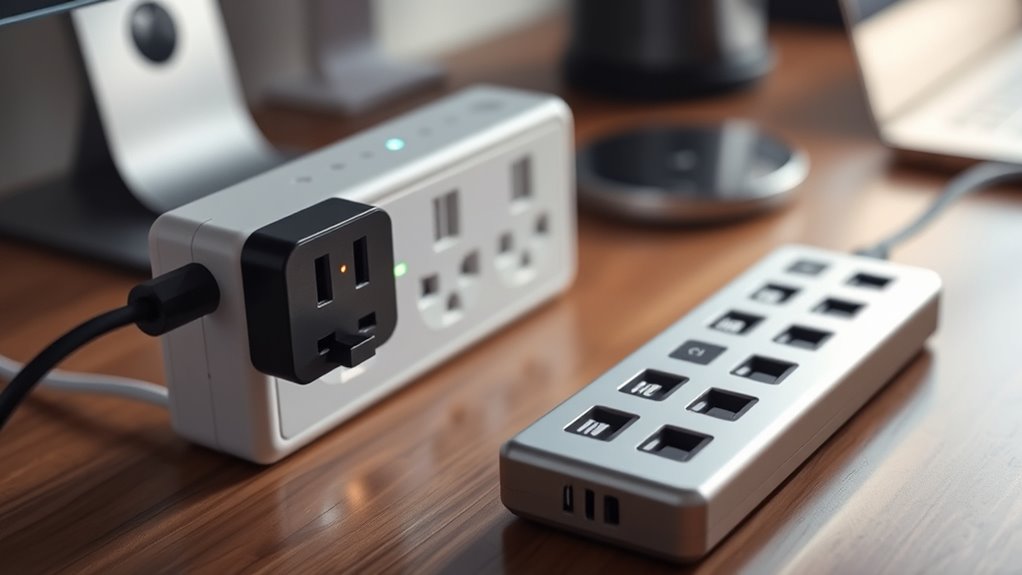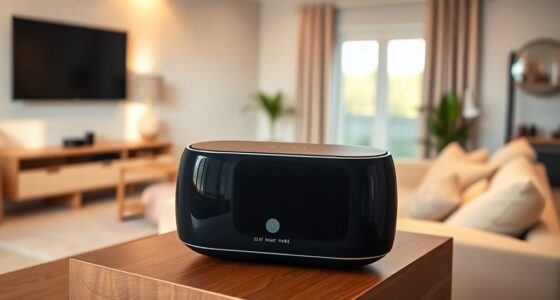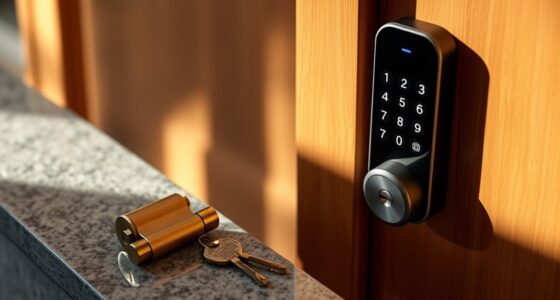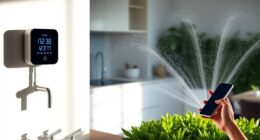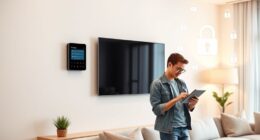Choosing between smart plugs and smart power strips depends on your needs. If you want control over individual devices like lamps or chargers, smart plugs are simple and easy to set up. But for managing multiple devices at once, especially in entertainment centers or workstations, a smart power strip offers better convenience and energy savings. To discover which option best fits your lifestyle and how to maximize their benefits, keep exploring your options.
Key Takeaways
- Use smart plugs for controlling individual devices like lamps or chargers, and smart power strips for managing multiple devices simultaneously.
- Smart plugs are easier to set up and ideal for simple device automation, while smart power strips support complex setups with surge protection.
- Choose smart plugs for targeted energy savings on specific appliances, and smart power strips to reduce standby power across multiple electronics.
- Smart power strips often support broader integration and automation protocols like Zigbee or Z-Wave, offering more advanced control options.
- Consider your device management needs: select smart plugs for specific device control, or smart power strips for managing entire groups of devices.
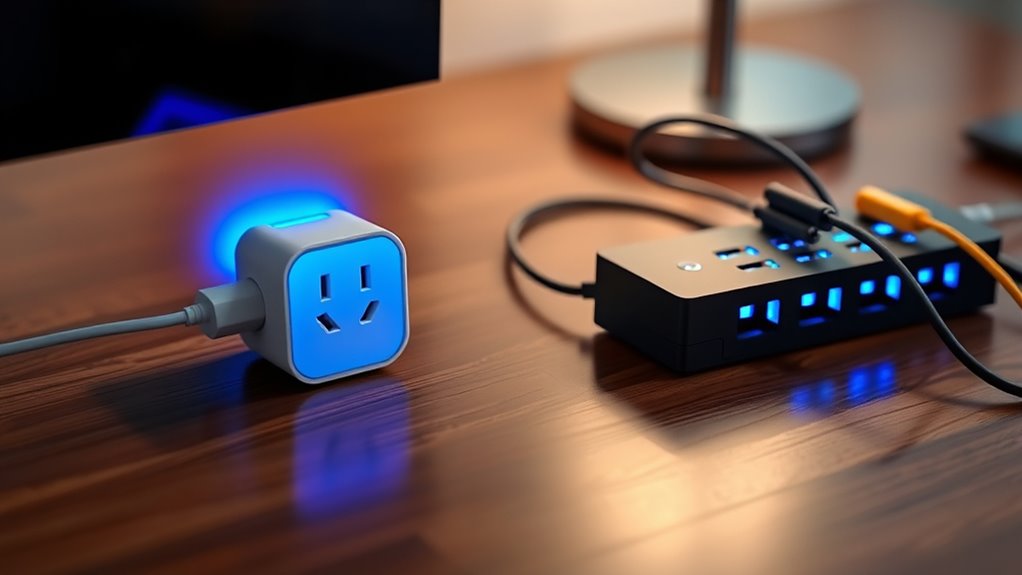
When it comes to making your home smarter, choosing between smart plugs and smart power strips can be confusing. Both options offer ways to control your devices remotely, but they serve different needs and come with distinct advantages. To decide which one suits you best, consider how each impacts energy efficiency and device compatibility. Smart plugs are small, individual devices that plug directly into your wall outlets, allowing you to control one appliance or device at a time. They are simple to set up and work well for turning on or off lamps, coffee makers, or chargers. Because they target specific devices, smart plugs can help you save energy by preventing standby power consumption. When a device is turned off via a smart plug, it’s truly off, not just in sleep mode, which can lead to noticeable energy savings over time.
On the other hand, smart power strips are designed to manage multiple devices at once through a single control point. They often have multiple outlets, some with individual switches, and sometimes include features like surge protection. This makes them ideal for entertainment centers, workstations, or home office setups where several devices—computers, monitors, printers—are used together. Smart power strips enhance energy efficiency by giving you the ability to turn off entire groups of devices simultaneously or set schedules for each outlet. This prevents unnecessary power drain from multiple devices left in standby mode, which is common in many households. Additionally, smart power strips tend to be more adaptable in managing device compatibility, especially for electronics that require surge protection or have specific power needs.
Device compatibility is essential when choosing between the two. Smart plugs typically work with most standard household outlets and are compatible with popular smart home ecosystems like Alexa, Google Assistant, or Apple HomeKit. However, their ability to control larger or specialized appliances might be limited depending on the plug’s capacity. Smart power strips, meanwhile, are better suited for managing multiple devices simultaneously and often support more complex setups. They usually connect via Wi-Fi or Zigbee/Z-Wave protocols, which can integrate into broader smart home systems, giving you more control and automation options. Incorporating sound design principles into smart home devices can also enhance user experience by providing clear auditory feedback for device control actions.
Frequently Asked Questions
Can Smart Plugs Control Appliances With High Power Consumption?
Smart plugs often have high power limitations, so they might struggle with appliances that draw a lot of power. You should verify the plug’s maximum wattage before connecting high-power devices. Additionally, look for surge protection features, which can safeguard your appliances from voltage spikes. For high-consumption appliances, a smart power strip with higher capacity and surge protection is usually a better choice to ensure safety and reliable control.
Are Smart Power Strips Compatible With All Smart Home Systems?
You’ll find that smart power strips vary in device compatibility, depending on their brand and model. Some integrate seamlessly with popular smart home systems like Alexa or Google Assistant, making control easy. However, others may have limited compatibility, so you need to verify the specific brand’s integration options before purchasing. To guarantee smooth operation, choose a smart power strip that matches your existing smart home ecosystem and supports the devices you want to manage.
Do Smart Plugs Require Wi-Fi to Operate?
Smart plugs do require Wi-Fi to operate, as they depend on your network for remote control and automation. Without Wi-Fi, you won’t be able to turn devices on or off remotely or set schedules. Make sure your Wi-Fi connection is stable for seamless control via your smartphone or voice assistant. If Wi-Fi drops, your smart plug’s functionality may be limited, so a reliable network is crucial for maximum use.
How Safe Are Smart Power Strips for Outdoor Use?
Did you know that over 60% of outdoor electrical accidents involve improper equipment? Smart power strips designed for outdoor use offer better outdoor safety and weather resistance, making them safer for your outdoor spaces. They’re built to withstand rain, snow, and humidity. Always choose a power strip rated for outdoor use, and verify it has proper weather resistance features to protect your devices and prevent electrical hazards.
Can Smart Plugs Be Used With Appliances That Have Timers?
You can use smart plugs with appliances that have timers, but you should verify their timers compatibility first. Smart plugs can help with appliance synchronization by turning devices on or off remotely. However, if your appliance relies heavily on its internal timer, the smart plug might interfere or cause conflicts. Always verify compatibility to ensure smooth operation and avoid any accidental disruptions.
Conclusion
Whether you choose a smart plug or a smart power strip, you’ll enjoy control, convenience, and energy savings. You can turn devices on or off with a tap, schedule routines to fit your lifestyle, and monitor usage effortlessly. Both options empower you to streamline your space, enhance safety, and boost efficiency. So, decide what suits your needs—compact control or expanded power—because either way, you’re making smarter choices for your home and your life.
